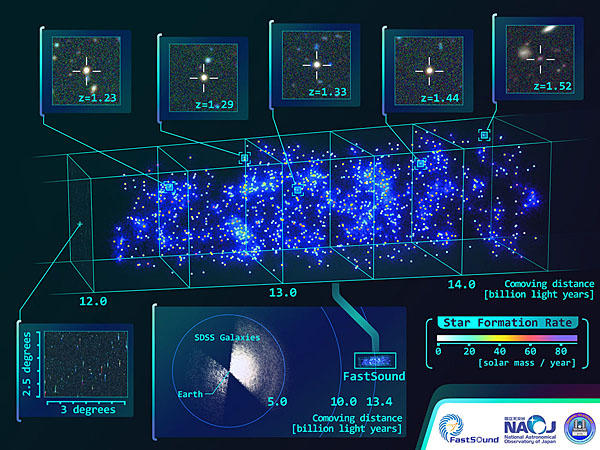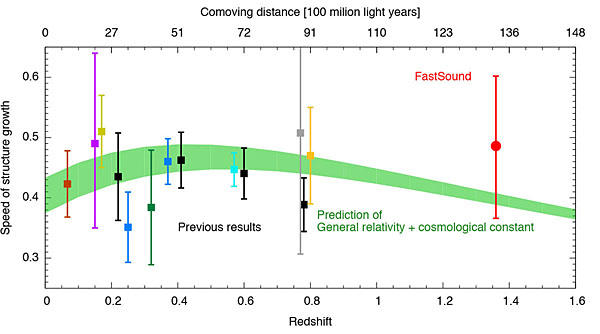NEWS
New test by deepest galaxy map finds Einstein's theory stands true
 Figure 1:A 3D map of the Universe spanning 12 to 14.5 billion light years (Credit: NAOJ; Partial data supplied by: CFHT, SDSS)
Figure 1:A 3D map of the Universe spanning 12 to 14.5 billion light years (Credit: NAOJ; Partial data supplied by: CFHT, SDSS)An international team led by Japanese researchers has made a 3D map of 3000 galaxies 13 billion light years from Earth, and found that Einstein's general theory of relativity is still valid.
Since it was discovered in the late 1990s that the universe is expanding at an accelerated rate, scientists have been trying to explain why. The mysterious dark energy could be driving acceleration, or Einstein's theory of general relativity, which says gravity warps space and time, could be breaking down.
To test Einstein's theory, a team of researchers led by Kavli Institute for the Physics and Mathematics (Kavli IPMU) Project Researcher Teppei Okumura, Kavli IPMU Project Assistant Professor Chiaki Hikage, University of Tokyo Department of Astronomy Professor Tomonori Totani, and together with Tohoku University Astronomical Institute Associate Professor Masayuki Akiyama and Kyoto University Department of Astronomy Associate Professor Fumihide Iwamuro and Professor Kouji Ohta, used FastSound Survey data on more than 3000 distant galaxies to analyze their velocities and clustering.
Their results indicated that even far into the universe, general relativity is valid, giving further support that the expansion of the universe could be explained by a cosmological constant, as proposed by Einstein in his theory of general relativity.
"We tested the theory of general relativity further than anyone else ever has. It's a privilege to be able to publish our results 100 years after Einstein proposed his theory," said Okumura.
"Having started this project 12 years ago it gives me great pleasure to finally see this result come out," said Karl Glazebrook, Professor at Swinburne University of Technology, who proposed the survey.
No one has been able to analyze galaxies more than 10 billion light years away, but the team managed to break this barrier thanks to the FMOS (Fiber Multi-Object Spectrograph) on the Subaru Telescope, which can analyze galaxies 12.4 to 14.7 billion light years away. The Prime Focus Spectrograph, currently under construction, is expected to be able to study galaxies even further away.
Details of this study were published online on April 27 in the Publications of the Astronomical Society of Japan.
 Figure 2:Experimental results looking at the expansion of the universe, in comparison to that predicted by Einstein's theory of general relativity in green. (Credit: Okumura et al.)
Figure 2:Experimental results looking at the expansion of the universe, in comparison to that predicted by Einstein's theory of general relativity in green. (Credit: Okumura et al.)Paper details
Journal: Publications of the Astronomical Society of Japan
Title: The Subaru FMOS galaxy redshift survey (FastSound). IV. New constraint on gravity theory from redshift space distortions at z~1.4
Authors: Teppei Okumura (1), Chiaki Hikage (1), Tomonori Totani (2), Motonari Tonegawa (2), Hiroyuki Okada (2), Karl Glazebrook (3), Chris Blake (3), Pedro G. Ferreira (4), Surhud More (1), Atsushi Taruya (1,5), Shinji Tsujikawa (6), Masayuki Akiyama (7), Gavin Dalton (8,9), Tomotsugu Goto (10), Takashi Ishikawa (11), Fumihide Iwamuro (11), Takahiko Matsubara (12,13), Takahiro Nishimichi (1,14), Kouji Ohta (11), Ikkoh Shimizu (15), Ryuichi Takahashi (16), Naruhisa Takato (17), Naoyuki Tamura (1), Kiyoto Yabe (1), and Naoki Yoshida (1,14,18)
Author affiliations:
1 Kavli Institute for the Physics and Mathematics of the Universe (WPI), The University of Tokyo Institutes for Advanced Study, The University of Tokyo, 5-1-5 Kashiwanoha, Kashiwa 277-8583, Japan
2 Department of Astronomy, School of Science, The University of Tokyo, 7-3-1 Hongo, Bunkyo-ku, Tokyo 113-0033, Japan
3 Centre for Astrophysics & Supercomputing, Swinburne University of Technology, P.O. Box 218, Hawthorn, VIC 3122, Australia
4 Department of Physics, University of Oxford, Denys Wilkinson Building, Keble Road, Oxford, OX13RH, United Kingdom
5 Yukawa Institute for Theoretical Physics, Kyoto University, Kyoto 606-8502, Japan
6 Department of Physics, Faculty of Science, Tokyo University of Science, 1-3 Kagurazaka, Shinjuku-ku, Tokyo 162-8601, Japan
7 Astronomical Institute, Faculty of Science, Tohoku University, 6-3 Aramaki, Aoba-ku, Sendai, Miyagi 980-8578, Japan
8 Astrophysics, Department of Physics, Denys Wilkinson Building, Keble Road, Oxford OX1 3RH, U.K.
9 RALSpace, STFC Rutherford Appleton Laboratory, HSIC, Oxford OX11 0QX, UK
10 Institute of Astronomy, National Tsing Hua University, No. 101, Section 2, Kuang-Fu Road, Hsinchu, Taiwan 30013
11 Department of Astronomy, Kyoto University, Kitashirakawa-Oiwake-cho, Sakyo-ku, Kyoto 606-8502, Japan
12 Department of Physics, Nagoya University, Furo-cho, Chikusa-ku, Nagoya 464-8602, Japan
13 Kobayashi-Maskawa Institute for the Origin of Particles and the Universe (KMI), Nagoya University, Furo-cho, Chikusa-ku, Nagoya 464-8602, Japan
14 CREST, JST, 4-1-8 Honcho, Kawaguchi, Saitama, 332-0012, Japan
15 Department of Earth & Space Science, Graduate School of Science, Osaka University, 1-1 Machikaneyama, Toyonaka, Osaka 560-0043, Japan
16 Faculty of Science and Technology, Hirosaki University, 3 Bunkyo-cho, Hirosaki, Aomori 036-8561, Japan
17 Subaru Telescope, National Astronomical Observatory of Japan, 650 North A'ohoku Pl., Hilo, HI 96720, USA
18 Department of Physics, School of Science, The University of Tokyo, 7-3-1 Hongo, Bunkyo, Tokyo 113-0033, Japan
DOI: 10.1093/pasj/psw029
Paper abstract (Publications of the Astronomical Society of Japan): http://pasj.oxfordjournals.org/cgi/content/abstract/psw029?ijkey=IuqXXzHiOH0Frrh&keytype=ref
Preprint (arXiv.org archive website): http://arxiv.org/abs/1511.08083
Useful links
All images can be downloaded from this page: LINK HERE
About the FastSound (FMOS Acceleration Samping Test Subaru Observation Understanding Nature of Dark energy) Survey: http://www.kusastro.kyoto-u.ac.jp/Fastsound/index.html
About the Prime Focus Spectrograph: http://pfs.ipmu.jp/
Contact:
Masayuki Akiyama
Associate Professor
Astronomical Institute, Tohoku University
Email: akiyama*.tohoku.ac.jp(Replace * with @)
Posted on:May 11, 2016




